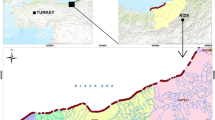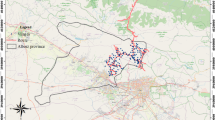Abstract
The purpose of the current study is to predict accident hot spots in different locations using Geographic Information System (GIS) and fuzzy logic. The data used contained accident types and occurrence time. Fatality and injury were also studied with spatial-temporal analysis. Moreover, accident hot spots were predicted performing Weighted Overlay Method (WOM) and Fuzzy Overlay Method (FOM), which are widely used in decision making and alternatives analysis based on the results obtained from Analytic Hierarchy Process (AHP). Point Density (PD) method was used to verify hot spots in urban region that resulted from the mentioned two methods. Traffic accidents’ hot spots were predicted for Irbid City in Jordan using the data of the accidents that occurred between 2013 and 2015. Both WOM and FOM proved to be successful in identifying hot spots in parts of study area when verified to PD surface. Final results showed that eight hot spots were pointed out; three are road sections and five are major intersections, which were analyzed to get accident-contributing factors and suggest the proper remedies.











Similar content being viewed by others

References
AECOM (2009) International road engineering safety countermeasures and their applications in the Canadian context. Transport Canada road report, Ottawa, Canada
Balist J, Karimi S, Noraisefat I, Mirkarimi A (2016) Fuzzy modeling to determine the optimum location of fire stations, with network analyst and ANP (case study: sixth district of Tehran). International Journal of Emerging Research in Management & Technology 5(4):2278–9359
Cheng Z, Zu Z, Lu J (2018) Traffic crash evolution characteristic analysis and spatiotemporal hotspot identification of urban road intersections. Sustainability 2019(11):160. https://doi.org/10.3390/su11010160
DOS (Jordan Department of Statistics) (2015) Final results of the 2015 population and housing census. http://dosweb.dos.gov.jo/censuses/population-and-housing/population-and-housing-2015/. Aug. 03, 2017
Edison T, Castro G (2014) Application of Bayesian techniques for the identification of accident-prone sections. DYNA Journal 81(187):209–214
Effati M, Rajabi M, Samadzadegan F, Shabani S (2014) A geospatial neuro-fuzzy approach for identification of hazardous zones in regional transportation corridors. International Journal of Civil Engineering 12(3):289–303
Environmental Systems Research Institute (ESRI) (2012) ArcGIS Release 10.1. Redlands, CA
Highway Capacity Manual (HCM) (2010) Transportation Research Board. Part III, Sections 15,16, and 17
Jayan K, Ganeshkumar B (2010) Identification of accident hot spots: a GIS based implementation for Kannur District, Kerala. International journal of Geomatics and Geosciences 1(1):51–59
Kundakci E (2014) Identification of urban traffic accident hot spots and their characteristics by using GIS. Master Thesis, Middle East Technical University, Turkey
Li L, Zhu L, Sui DZ (2007) A GIS-based Bayesian approach for analyzing spatial-temporal patterns of intra-city motor vehicle crashes. J Transp Geogr 15:274–285
Ma L, Yan X, Qiao W (2014) A quasi-Poisson approach on modeling accident hazard index for urban road segments. Discrete Dynamics in nature and society, New York, NY
Miqdady T (2017) Identification of traffic accidents hot spots in Irbid City - Jordan using geographic information system. Master Thesis, Jordan University of Science and Technology, Jordan
Mitra S (2008) Enhancing road traffic safety: a GIS based method to identify potential areas of important. Transportation Research Board (TRID), California Polytechnic State University. San Luis Obispo, CA USA 93407
Molla M, Stone M (2014) Geostatistical approach to detect traffic accident hot spots and clusters in North Dakota. UGPTI Department Report, No. 276
Onden I, Eldemir F (2013) GIS and f-AHP integration for locating a new textile manufacturing facility. FIBRES & TEXTILES in Eastern Europe 5(113):18–22
Prasannakumar V, Vijith H, Charutha R, Geetha N (2011) Spatio-temporal clustering of road accidents GIS based analysis and assessment. Procedia Soc Behav Sci 21:317–325
Rodrigues DS, Ribeiro PJG, da Silva Nogueira IC (2015) Safety classification using GIS in decision-making process to define priority road interventions. J Transp Geogr 43:101–110
Satria, Castro (2016) GIS tools for analyzing accidents and road design: a review. Transportation Research Procedia 18(1):242–247
Tortum A, Atalay A (2015) Spatial analysis of road mortality rates in Turkey. Proc Inst Civ Eng Transp 168(6):532–542. Thomas Telford Ltd
World Health Organization (WHO) (2004) World report on road traffic injury prevention. Geneva, Switzerland
World Health Organization (WHO) (2009) Global status report on road safety 2009: time for action. Geneva, Switzerland
World Health Organization (WHO) (2013) Global status report on road safety 2013: supporting a decade for action. Geneva, Switzerland
Xie Z, Yan J (2013) GIS-based economic cost estimation of traffic accidents in St. Louis, Missouri. Proc., 13th COTA International Conference of Transportation Professionals, Social and Behavioral sciences, vol 96, pp 2907–2915
Yalcin G, Duzgun HS (2015) Spatial analysis of two-wheeled vehicles traffic crashes: Osmaniye in Turkey. KSCE J Civ Eng 19(7):2225–2232
Yearly Statistical Report of Traffic Accidents in Jordan (2014) Public Security, Traffic Institute, pp 5, 38
Young J, Park PY (2014) Hot zone identification with GIS-based post-network screening analysis. J Transp Geogr 34:106–120
Author information
Authors and Affiliations
Corresponding author
Rights and permissions
About this article
Cite this article
Al-Omari, A., Shatnawi, N., Khedaywi, T. et al. Prediction of traffic accidents hot spots using fuzzy logic and GIS. Appl Geomat 12, 149–161 (2020). https://doi.org/10.1007/s12518-019-00290-7
Received:
Accepted:
Published:
Issue Date:
DOI: https://doi.org/10.1007/s12518-019-00290-7



